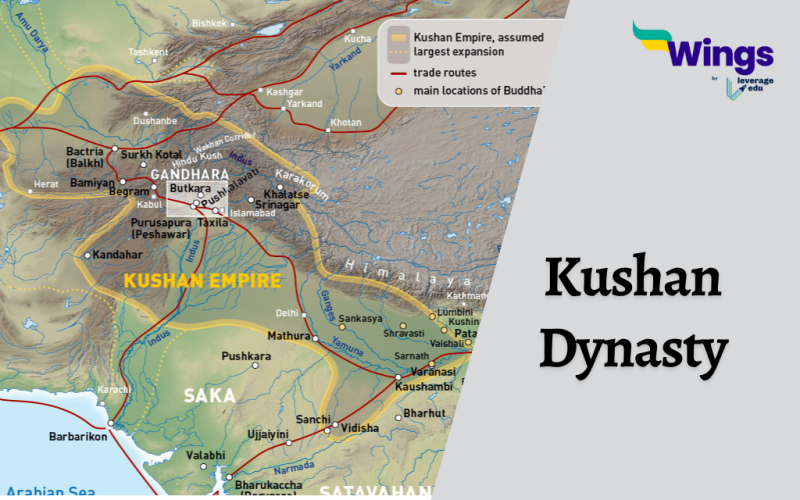The Kushan Dynasty, also known as the Kushans was a powerful empire that flourished from the 1st to the 3rd century CE in the region of present-day India, Pakistan, and Afghanistan. They were known for their military prowess, cultural achievements, and their role in establishing trade networks between the East and the West. In this article, we will delve into the history of the Kushan Dynasty, explore the reigns of its notable kings, and examine the factors that led to its eventual decline.
The Rise of the Kushan Dynasty
The Kushan Dynasty was founded by Kujula Kadphises around 30 CE. Initially, the empire was confined to the regions of Bactria and Sogdia, which are now parts of Afghanistan and Uzbekistan. Kujula Kadphises successfully united various Yuezhi tribes and established himself as the first Kushan Emperor. In some Chinese sources, they were also known as the Giuishuang. They even defeated the Sakas and the Parthians in the 1st century AD.
Also Read – Tughlaq Dynasty: Rulers of Delhi Sultanate
List of Kings and Their History
- Kujula Kadphises (30-80 CE): Kujula Kadphises laid the foundation of the Kushan Empire by subjugating neighbouring territories like Kabul, Afghanistan and Kadar. He established a powerful empire in Central Asia and expanded the empire’s boundaries with diplomatic relations with Rome and China.
- Vima Kadphises (80-90 CE): Vima Kadphises also known as Vimak Taktu or Sadashkana was the son of Kujula Kadphises. During his reign, he continued to expand the Kushan Empire and consolidated its control over the Silk Road trade routes. He extended the Kushan Dynasty’s territorial influence to the Punjab region of the Indian subcontinent.
- Kanishka I (127-150 CE): Kanishka I was the most well-known and powerful ruler of the Kushan Dynasty. He expanded the empire to its greatest extent and reached as far as present-day Iran and northern India. Kanishka I also presided over a period of great cultural and religious diversity embracing Buddhism and promoting Gandhara art.
During his reign, the capital was Purushpura, now Peshawar. He was the patron of the Fourth Buddhist Council and under his rule, Gandhara Art flourished to its peak.
- Huvishka (150-180 CE): Huvishka was the successor of Kanishka I. During his reign, he continued to promote cultural and artistic developments. Huvishka is known for his patronage of Buddhist art and for issuing coins that depicted images of various deities.
- Vasudeva I (190-230 CE): Vasudeva I was the last ruler of the Kushan Dynasty. His reign witnessed internal conflicts and external invasions, weakening the empire’s grip on its territories.
Also Read – Chera Dynasty: Kings, Administration, Religion & Conquests
The Decline of the Kushan Empire
The decline of the Kushan Dynasty can be attributed to various factors –
- Internal Conflicts: Towards the later years of the empire, internal power struggles and regional revolts weakened the Kushan Dynasty’s central authority.
- Barbarian Invasions: The Huns, a nomadic tribe from Central Asia invaded the Kushan Empire leading to further fragmentation and loss of control over territories.
- Economic Decline: The disruption of trade routes and decline in agricultural productivity resulted in economic hardships for the empire, making it vulnerable to external threats.
- Buddhist-Hindu Conflict: The rise of Hinduism as a dominant religion and the subsequent decline of Buddhism created divisions within the empire, weakening its social cohesion.
Also Read – Haryanka Dynasty: Rulers of Magadha Empire
The Kushan Dynasty with its rich history and cultural achievements, left a lasting imprint on the regions it once ruled. From its humble beginnings to its glorious peak under rulers like Kanishka I, the empire shaped the socio-political scenario of Central Asia. However, internal conflicts, external invasions, and economic downturns spelt the end of the Kushan Dynasty.
Relevant Blogs
That’s all about the Kushan Dynasty! If you want to know more about topics like this, then visit our general knowledge page! Alternatively, you can also read our blog on general knowledge for competitive exams!
 One app for all your study abroad needs
One app for all your study abroad needs













